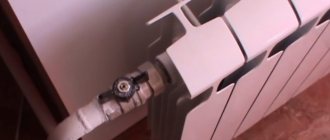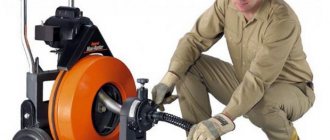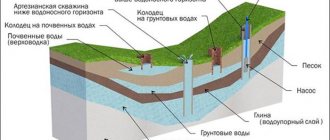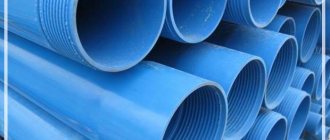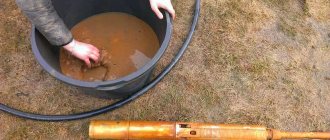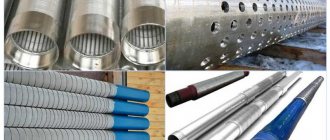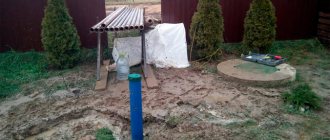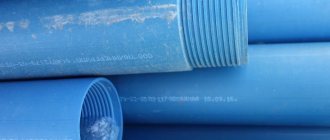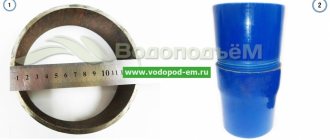- Why is air coming out of the well?
- How to get rid of air in a well
- How much does it cost to repair a well?
- Call a well specialist
Every year, autonomous sources of water supply are becoming more and more popular and in demand among owners of private houses and country cottages. This is justified by the fact that this type of independent water supply provides more advantages, even despite the high cost of drilling and construction. First of all, your own well allows you to provide your home with regular and uninterrupted water supply, regardless of connection to a centralized water main. In addition, the service life of such a hydraulic structure can reach 50-70 years, subject to compliance with operating rules and timely maintenance.
Other reasons for the appearance of air bubbles in the well and ways to eliminate them
When using a well to pump out small volumes of water or seasonal operation of the structure, several possible causes and ways to eliminate them are possible.
So, why does the pump pump not only water, but also air: Suction of air mass in the suction section. In this case, water and air flow for a long time, but the problem can only be “cured” by completely replacing the pipeline and all related elements. You can check by removing the pipeline from the well and pumping water, for example, in the bathroom. Low filling of the aquifer with large pumping. Reducing volumes or drilling a new well would be the best solution
It is only important not to break through to the old thin aquifer, so as not to get water again with air from the well. Pump failure when the gland seal is weak, as a result of which air bubbles end up in the discharge chamber and water flows with the air. You will have to disassemble the device yourself or it’s easier to take it to a repair shop.
Hydraulic systems are similar to electric systems - the laws are the same. Understanding the problem of why a pumping station pumps air is sometimes only possible with a series of technical measures. And if the proposed options for identifying the problem and eliminating deficiencies did not help and the water also comes with air, it is better to contact the professionals who service the pumps. The cost of the service starts from $50, but you will be freed from the problem and will be able to find out exactly why your pump does not pump water as you would like.
Reasons for jerking
Manifestations also vary. This is when the water from the tap comes out in jerks or when there is a surge in the pressure created by the pump when sucking liquid from a well or well.
Most often, this situation occurs because:
- An air lock has formed in the pipeline. As a result, the pumping station works to push it through, and periodically this succeeds, but as soon as the pressure breaks through, the pressure drops, and the pump is forced to pump up pressure in the system again.
- The pressure switch has failed. The pressure gauge shows correctly, but the pump does not turn on and off in a timely manner. This is due to an underestimated upper limit or an overestimated lower threshold.
- The system has depressurized. This could be a hole in the pipeline, an insufficiently tight connection, poor-quality shut-off valves, or damage to the working chamber of the pump, as well as failure of its mechanical components.
In each case, repairs must be made. A preliminary audit is carried out in order to identify the true cause. If there are no visible consequences, you have to go through the entire chain from the well to the consumer.
How to protect the station from breakdowns
In order to never puzzle over why water flows unevenly through the pipes, it is enough to initially assemble the system correctly.
If the problem is already evident, then after the repair you need to check whether everything was done correctly at the stage of arranging the source. Thus, pipes and hoses should not be kinked or deformed, which leads to a decrease in throughput.
The system includes a check valve that prevents the reverse flow of liquid through the pipeline. Check whether the pump power is selected correctly. To do this, the calculation takes into account the depth of water in a well or well, the distance of the source from the house, and the number of consumers. The flow rate of the source cannot be less than the productivity specified in the technical passport for the pumping station.
Any leaky connection can cause air leaks, which causes interruptions in the water supply. And attempts to save money by excluding any of the nodes from the system always leads to the fact that it works inefficiently. But all this can be corrected if you select all the components correctly and install them in the right sequence. The procedure is simple if you approach the issue with due care.
Water from a well comes with air. Why is water supplied with air?
The popular idea is that artesian water is something like gold and is pure, like the soul of a baby. But in reality it is just a well drilled into a confined aquifer. This means that having drilled down to the aquiferous limestones, the water level will rise higher than it was. That's all, such waters are called artesian, which makes the quality of artesian water no better or worse than in ordinary free-flow limestone wells. Artesian is just a term, but today they have begun to designate all wells on limestone. Sometimes the water level rises so high that it begins to flow out of the well itself. We wrote about self-outpouring.
The most important thing in artesian wells is not the purity of the water, the main thing is the flow rate. It is enough to supply water to any private home, industry or even a village. This is why drilling artesian wells for water has become so popular today.
Now we will tell you the whole truth about artesian wells and what is important to know about them.
At what depth is artesian water
No one can definitively answer at what depth to drill an artesian well, including magical dowsers. There is only one reason for this: geology. Artesian water lies in limestone (which is why it is sometimes called a limestone well) and these aquiferous limestones can be located at any depth, sometimes 50 meters, and sometimes 150 meters. To find out at what depth artesian water lies, you need to look at a map of the depths of wells in the Moscow region (or your region), or even better, interview neighbors who have already drilled a well. It is very likely that you will have something similar. In your region, artesian waters may lie in other rocks, but this does not change the essence of the matter.
Artesian well pros and cons
It is important for you, as the owner of a house, to have a sufficient amount of water, which means there are no alternatives and you need to drill for limestone. This is the first and most basic advantage of an artesian well - high flow rate. No sand wells can compare with it in this component
The second plus and second advantage of an artesian well: there is always water. Regardless of the season, be it summer or winter, rain or drought, the water level in the well is stable and the pressure is also stable.
Maintenance of a proper artesian well is never required at all, this is another plus. A competently (!) made structure will last its entire service life and you do not need to worry about it. Typically, the service life of an artesian well is more than 50 years. This is possible with proper arrangement, provided that high-quality pipes, materials and quality work are used. Unfortunately, today no one does this; today everyone is trying to give the lowest price. Only water-lifting equipment requires maintenance, but that’s a completely different story.
- Debit.
- There is always water.
- Does not require maintenance.
- Water quality.
Disadvantages of artesian wells
There are no disadvantages to limestone wells. You can often hear about hard water containing too much iron... This is possible, but if there are no alternatives, then you need to work with what you have. To find out whether your water from an artesian well is beneficial or harmful, first, thoroughly pump the water for 2-3 weeks. Then, you can submit artesian water for analysis and if there are excesses, then under
At what depth is artesian water
No one can definitively answer at what depth to drill an artesian well, including magical dowsers. There is only one reason for this: geology. Artesian water lies in limestone (which is why it is sometimes called a limestone well) and these aquiferous limestones can be located at any depth, sometimes 50 meters, and sometimes 150 meters. To find out at what depth artesian water lies, you need to look at a map of the depths of wells in the Moscow region (or your region), or even better, interview neighbors who have already drilled a well. It is very likely that you will have something similar. In your region, artesian waters may lie in other rocks, but this does not change the essence of the matter.
At what depth is artesian water
The only way to tell is to pull the pump out and inspect it. Spending a couple hundred dollars to research and repair your system is much more economical than spending several thousand on a new well! One simple way to check if the well is drying up is to remove the tube from the dry adapter and run it for a while. This is typically a job that involves hauling a derrick truck and we are happy to come take a look if you give us a call. First, we raise the pump about 5 feet and check to see if there is any standing water in the pipe.
Air vent in a water supply system: purposes of application, installation location, alternative solutions
Automatic vent for hot water supply
Today we have to find out why we need to install an air vent in the water supply system. In addition, we will find out in which part of the water supply circuit it can be installed, what kind of air vents can be used there, and how to solve the problem of air in the water supply without an air vent. Let's get started.
Artesian well pros and cons
It is important for you, as a home owner, to have a sufficient amount of water, which means there are no alternatives and you need to drill for limestone. This is the first and most basic advantage of an artesian well - high flow rate. No sand wells can compare with it in this component
If there's no water at the top of the pipe, then we know it's probably a hole or sinkhole. If you're worried about a dry well, that's good news—it'll probably save you a lot of changes. So let's say the pump is up and we have water in the pipe. The next step is to turn on the pump and start it up. If it rocks for a few minutes and then runs away, that's bad news - your well is being pumped out.
Here's a cross-section of what things look like underground before turning on the pump. The top of the aquifer is about the same as the water located in your well. This point is called the static water level, or sometimes the pump level.
The second plus and second advantage of an artesian well: there is always water. Regardless of the season, be it summer or winter, rain or drought, the water level in the well is stable and the pressure is also stable.
Maintenance of a proper artesian well is never required at all, this is another plus. A competently (!) made structure will last its entire service life and you do not need to worry about it. Typically, the service life of an artesian well is more than 50 years. This is possible with proper arrangement, provided that high-quality pipes, materials and quality work are used. Unfortunately, today no one does this; today everyone is trying to give the lowest price. Only water-lifting equipment requires maintenance, but that's a completely different story.
When we set up a water system for a new well, we must determine from what depth it is being pumped. The pump only needs to lift water from the pumping level to the surface, so we calculate the pump size based on the static water level.
What is cavitation
Quick note: not all pumps are created equal. Not only do they have different capacities, but they are also designed to hold different amounts of water and are designed to pump from different depths. We make sure to optimize the pump to the specifications of your well and water supply system. On our Pumps page. When you turn on the pump, this is what happens to the water in the aquifer.
- Debit.
- There is always water.
- Does not require maintenance.
- Water quality.
Disadvantages of artesian wells
There are no disadvantages to limestone wells. You can often hear about hard water containing too much iron... This is possible, but if there are no alternatives, then you need to work with what you have. To find out whether your water from an artesian well is beneficial or harmful, first, thoroughly pump the water for 2-3 weeks. Then, you can submit the artesian water for analysis and if there are excesses, then it is advisable to do water treatment for them and bring the composition of the water to potable. In both a sand well and a well, the water quality is incomparably lower than artesian water, and for them a filtration system is required if you plan to drink the water.
This is called drawdown, and the area affected by the pump is called the cone of drawdown. The shape of the cone depends on the type of rock and soil you have in your area. The cone shows how far your well is affecting your neighbors and also gives you an idea of how long it will take to recharge once the pump is turned off.
What should the water level be in a dry log?
First of all, if there is less water in the aquifer, you can pump out enough water to bring the water level down to the pump level. The pump then begins to suck air like a straw into the bottom of an empty soda cup. This can cause air to enter the water or water to escape while the sprinklers are operating.
The only possible disadvantage is the price of a ready-made turnkey artesian well. Due to the depth, you will pay 50,000-80,000 rubles more one-time. But you are making a solid structure that will serve you for decades.
The price is slightly higher due to the depth.
Types of water aeration
In addition to ways to increase air concentration, there is a division according to a number of parameters. This includes the level of complexity of the equipment used and the nature of the reagents used. But there is one factor that stands out. This is a method of supplying oxygen, and, in accordance with it, there are two schemes - let’s move on to consider the first.
SF-mix manual up to 0.8 m3/h
AMETHYST - 02 M up to 2 cubic meters/day.
Aeration unit AS-1054 VO-90
Gravity
The short gist is this:
- The liquid enters the tank through nozzles (special nozzles), that is, with dispersion.
- As they fall, the droplets mix with the air contained in the atmosphere.
- At the same time, the membrane compressor also pumps oxygen at the bottom.
- Interacting, the molecules are oxidized, and the dissolved forms contained in the water precipitate and are removed by filters.
- The working medium is pumped out using a pump and supplied to the end points of consumption.
Installations operating on this principle are used when the liquid contains excess salts, hydrogen sulfide and methane, as well as in cases of excessive color and turbidity or the presence of an unpleasant aroma.
Non-pressure systems built on the basis of the method differ in size and performance, and while some of them are aimed at cottages and country houses, others will satisfy the needs of even large industrial enterprises. They are quite environmentally friendly and safe, so it is permissible to supplement their capabilities with reagent cleaning - in the presence of a serious excess of organic compounds and/or low pH levels.
Let's move on to the second scheme.
Nadornaya
The most widespread technology - due to its economic profitability, speed of implementation and complete absence of harm to the environment. This is implemented in the following way:
1. Water is taken from the source and then supplied to the inlet of the purification column through a flow sensor.
2. Having received the appropriate signal, the flow switch starts the compressor, which begins to pump air into the container through the tube.
3. The liquid is mixed with gas and thus saturated with oxygen and poured into a reservoir under significant pressure.
4. This mixture is allowed to settle for 30 minutes (or longer) to allow oxidation reactions to occur and sediment to settle, after which it is passed through filters that absorb solid particles and sent to points of consumption.
Or another scheme is possible:
- The working medium is collected in a volumetric container, for example, in a special column.
- At the level of the middle of the tank, oxygen is supplied, which begins to rise.
- Reaching the top, the gas not only naturally starts the aeration process, but also systematically accelerates it.
Composition of the pumping station and purpose of parts
A pumping station is a collection of individual devices connected to each other. To understand how to repair a pumping station, you need to know what it consists of and how each part works. Then troubleshooting is easier. Composition of the pumping station:
Each part is responsible for a specific parameter, but one type of malfunction can be caused by the failure of various devices.
Operating principle of the pumping station
Now let's look at how all these devices work. When the system is first started, the pump pumps water into the accumulator until the pressure in it (and in the system) is equal to the upper threshold set on the pressure switch. While there is no water flow, the pressure is stable, the pump is turned off.
Somewhere they opened a tap, drained the water, etc. For some time, water comes from the accumulator. When its quantity decreases so much that the pressure in the accumulator drops below a threshold, the pressure switch is activated and turns on the pump, which pumps water again. It is again switched off by the pressure switch when the upper threshold is reached - the shutdown threshold.
If there is a constant flow of water (a bathtub is being filled, the watering of the garden is turned on), the pump runs for a long time: until the required pressure is created in the hydraulic accumulator. This periodically happens even when all the taps are open, since the pump supplies less water than flows out from all points of analysis. After the flow has stopped, the station operates for some time, creating the required reserve in the gyroaccumulator, then turns off and turns on after water flow appears again.
Cavitation and its elimination
The cause of cavitation is incorrectly selected pumping equipment. Water devices are selected taking into account the diameter of the well. For sizes less than 100 mm, plunger or circular models are suitable, 100 mm and more - submersible.
Cavitation is a violation of the density of the water column, in other words, the filling of the pipeline with air bubbles. Formed in areas with reduced pressure at a critical level. The phenomenon is accompanied by the formation of voids in the pipeline, bubble formations formed as a result of the interaction of gases and vapors released by well water.
It is not always possible to determine the faulty area yourself, since special equipment is required. It is also worth adding that this area may be unstable. If measures are not taken, the consequences will hit the pocket hard - dynamic effects on flow and vibration will lead to breakdown of pumping equipment.
To reduce the likelihood of a problem developing, you need to choose the right water pumps, taking into account the volumes of water consumed and the technical characteristics of the well.
To get rid of such an unpleasant phenomenon as the appearance of air in water, you need to consider the main ways to solve the problem:
Replace the small diameter pipe with a larger diameter pipe. Install pumping equipment closer to the storage tank
When transporting the pump, it is important to take into account the established standards: the interval between the container and the pump must be no less than 5 diameters of the suction pipe. Replace the valve with a gate type and remove the check valve. To reduce the pressure in the pipeline, the pipe is replaced with a smooth one. There should not be many turns in the suction pipe. To solve the problem, you need to replace small radius bends with large ones or simply reduce them
At the design stage of an autonomous water supply system, it is recommended to place all outlets in the same plane and use flexible pipes rather than rigid ones.
To solve the problem, you need to replace small radius bends with large ones or simply reduce them. At the design stage of an autonomous water supply system, it is recommended to place all outlets in the same plane and use flexible pipes rather than rigid ones.
Danger of air bubbles in the pipeline
Water hammer can rupture a pipe
Bubbles, especially large ones, can destroy even strong elements of the highway. The main troubles they cause to owners of private houses:
- They accumulate in the same areas, leading to breakdowns of pipe sections and adapters. They also pose a risk for turning and twisting pipe sections where air is trapped.
- They break the water flow, which is inconvenient for the user. The taps “spit out” water all the time and vibrate.
- Causes water hammer.
Water hammer leads to the formation of longitudinal cracks, which causes the pipes to gradually collapse. As time passes, the pipe breaks at the point of cracking and the system stops functioning.
Therefore, it is important to equip additional elements that allow you to quickly get rid of dangerous bubbles
The main causes of air jams
If air pockets occur, check the tightness of the connections.
The appearance of bubbles in the water supply lines is associated with an internal physical and chemical reaction or penetration from the outside. In the first case, gas escapes from the water flow itself, because approximately 30 grams of air are dissolved in 1000 liters of water. The release of a gaseous substance occurs faster if the liquid flows slowly and if it is heated. It is for this reason that voids and cavities occur much more often in hot water pipes. In the second case, air from the external environment leaks into the main networks.
The main reasons for the appearance of air from outside in the water supply system of a private home:
- when the liquid level decreases, air can be sucked in through the non-return valve;
- the fitting elements with rubber sealing parts are poorly covered, depressurization occurs at the joints;
- the air in the water supply lines was not removed from the first start-up of the system.
In vertically directed pipes, air rises upward or is absorbed throughout the cavity. In horizontal ones, it accumulates in the highest places, which is unfavorable for the entire system.
The destruction of air bubbles occurs at a flow speed of a quarter of a meter per second. If it is smaller, the traffic jams may remain in one place for a long time.
The advantages of this method
As already mentioned, this method has a number of significant advantages. Let's highlight the main advantages of drilling with purge:
- Reducing the cost of work and increasing output. Price for drilling 1 linear meter is reduced by approximately 30% due to the lack of consumption for water delivery and production;
- Can be used on hard, rocky and loose porous rocks. It is the porous layers that absorb the drilling fluid, so blowing the well is the only option for constructing a water intake well;
- Increased destruction and recovery of waste rock reduces drilling time by several times. The circulating air carries the rock through the annulus in just a few seconds;
- Blowing allows you to drill wells in winter at temperatures below 0C, since equipment for heating the liquid and rock is not required;
- The use of atmospheric compressed air reduces mechanical stress and pressure on drilling equipment, reducing wear and increasing service life.
The only disadvantage worth noting is the need to use a powerful compressor. It represents a separate unit of equipment and, of course, its delivery and operation, which is naturally included in the cost of the work.
It should be especially noted that all drilling operations are carried out using professional equipment, compressors, and pumps operating under high pressure. They should only be carried out by professional workers. When choosing a contractor, you should not chase a low price, but act responsibly and choose highly qualified specialists in this field.
Share with friends
Why does water from a well, boiler, well or pipe smell like hydrogen sulfide?
Water from a well, boiler, well or pipes may suddenly begin to smell of hydrogen sulfide. The smell is identical to that of "rotten eggs". The reason for the smell of hydrogen sulfide is the proliferation of bacteria in the water. Water from the city water supply is usually specially prepared, highly disinfected, chlorinated, and such cases rarely occur with it.
Large amounts of hydrogen sulfide gas (H2S) are released and accumulated as a result of the activity of sulfate-reducing (sulfate-reducing) bacteria in water.
Sulfate-reducing bacteria (SRB) use organic matter (CH2O) or hydrogen (H) as an electron donor and sulfate (SO4) as an electron acceptor to produce energy
2CH2O + SO42- + 2H+ => 2CO2 + H2S + 2H2O
Simply put, there are two types of sulfate-reducing bacteria. Both varieties require sulfates - sulfur compounds - as well as hydrogen to survive. But one type of bacteria extracts hydrogen from organic matter in the sludge. Other bacteria use molecular hydrogen, which is found in water.
IMPORTANT ! The development of sulfate-reducing bacteria occurs under anaerobic conditions, in the absence of free oxygen in water. Sulfates are salts of sulfuric acid H2SO4
For example, potassium sulfate K2SO4, sodium hydrogen sulfate NaHSO4. Sulfates are widespread in nature, forming a whole group of minerals. Many sulfates are soluble in water and are found in natural water.
Sulfates are salts of sulfuric acid H2SO4. For example, potassium sulfate K2SO4, sodium hydrogen sulfate NaHSO4. Sulfates are widespread in nature, forming a whole group of minerals. Many sulfates are soluble in water and are found in natural water.
Other reasons for the appearance of air bubbles in the well and ways to eliminate them
When using a well to pump out small volumes of water or seasonal operation of the structure, several possible causes and ways to eliminate them are possible. So, why does the pump pump not only water, but also air:
Suction of air mass in the suction section. In this case, water and air flow for a long time, but the problem can only be “cured” by completely replacing the pipeline and all related elements. You can check by removing the pipeline from the well and pumping water, for example, in the bathroom. Low filling of the aquifer with large pumping. Reducing volumes or drilling a new well would be the best solution
It is only important not to break through to the old thin aquifer, so as not to get water again with air from the well. Pump failure when the gland seal is weak, as a result of which air bubbles end up in the discharge chamber and water flows with the air. You will have to disassemble the device yourself or it’s easier to take it to a repair shop.
Hydraulic systems are similar to electric systems - the laws are the same. Understanding the problem of why a pumping station pumps air is sometimes only possible with a series of technical measures. And if the proposed options for identifying the problem and eliminating deficiencies did not help and the water also comes with air, it is better to contact the professionals who service the pumps. The cost of the service starts from $50, but you will be freed from the problem and will be able to find out exactly why your pump does not pump water as you would like.
Why does a well pump pump water in jerks?
The water supply system is one of the main elements of a comfortable and modern home. Water supply based on a well is an almost obligatory element of any cottage, house or even summer house.
Well arrangement diagram
Of course, as soon as the water supply begins to fail, all residents of the household will notice it, since you can only last a few hours without water. And this period depends on how many residents live in the house.
Therefore, it is quite rare to save on utility network equipment, especially well pumps.
(repairing a pump is an adventure worthy of the strong in spirit and strong in body: since the pump needs to be taken out of the well, and after repair, put back down).
But even the highest quality and most reliable mechanism can fail over time. One of the main and most common problems associated with well pumps is that it either completely stops supplying water, or does so intermittently.
The article will discuss the reasons why a well pump pumps water in jerks. We will also provide possible solutions.
Determining the problem yourself and eliminating it in a timely manner will allow you to save your money. However, it is better to entrust this work to professionals.
Reasons for the appearance of air in a water well
As a rule, the problem of air getting into the water is faced by households who use small volumes of water from a source or when using pumping equipment seasonally. The causes of this phenomenon may be the following problems in the system:
The air suction at the water suction point has failed. The problem will not be solved until the pipeline is completely replaced with all the necessary parts. It’s easy to make sure that it’s working properly – just pump the water in the pipeline, for example, in the bathroom. Breakdown of the pumping equipment itself due to irregular or poor quality maintenance. Air bubbles are formed as a result of a weak gland seal. The solution to the problem is to disassemble the working unit of the station and fix the damage. Insufficient filling level of the well during large pumping. Drilling a new well, purchasing a less powerful pump, reducing the volume of water used can solve the problem
However, when drilling a new well, it is important not to reach the same aquifer, where the likelihood of airing the system again is very high.
If water from a well comes in jerks and with air, detailed technical diagnostics are required to establish the exact cause. The operating principle of hydraulic and electrical systems is the same. If it is not possible to perform the operation at home, it is better to take the pumping equipment to a service center.
If the water is completely gone
This phenomenon often happens if your well is no longer new and has been in operation for more than three years. Often such a well, dug to the level of the high water, produces either a small volume of water over time, or the water in it runs out (dries up) completely. The reason is the work of the aquifer at two or more points or its drying out. In this case, you need to either make (drill) a new well (or better yet, an artesian well), or deepen the old one to a depth of more than 10 meters. The decision is made based on financial capabilities and the available area of the site.
Reasons for the appearance of air in a water well
As a rule, the problem of air getting into the water is faced by households who use small volumes of water from a source or when using pumping equipment seasonally. The causes of this phenomenon may be the following problems in the system:
The air suction at the water suction point has failed. The problem will not be solved until the pipeline is completely replaced with all the necessary parts. It’s easy to make sure that it’s working properly – just pump the water in the pipeline, for example, in the bathroom. Breakdown of the pumping equipment itself due to irregular or poor quality maintenance. Air bubbles are formed as a result of a weak gland seal. The solution to the problem is to disassemble the working unit of the station and fix the damage. Insufficient filling level of the well during large pumping. Drilling a new well, purchasing a less powerful pump, reducing the volume of water used can solve the problem
However, when drilling a new well, it is important not to reach the same aquifer, where the likelihood of airing the system again is very high.
If water from a well comes in jerks and with air, detailed technical diagnostics are required to establish the exact cause. The operating principle of hydraulic and electrical systems is the same. If it is not possible to perform the operation at home, it is better to take the pumping equipment to a service center.
If the water level in the well drops
Scheme of groundwater levels
Do you use your well all year round and have never noticed a lack of water in your home before? Are you faced with a situation where the water in the well quickly runs out or periodically there is no water at all to the bottom level? Why did this happen? Let's look at possible causes and solutions to the problem. The main prerequisite for such source behavior may be:
- Natural change in geological conditions at the location of your well. That is, there is a displacement of the bottom of the formation from which you draw water).
- Changes in aquifers by season (most often in the summer the reservoir can decrease, in the cold season it can increase).
- Defects. allowed during the construction of the well or during its operation (here we mean an insufficiently deep well, lack of sealing of the rings, the appearance of cracks, an incorrectly selected filter, etc.).
- Silting of filters (if the well has not been used for a long time).
Elimination of cavitation
What can be done to avoid the appearance of air in the well and the entry of water with bubbles:
- Replacing a small-diameter suction pipe with a larger one;
- Moving the pump closer to the storage tank.
Attention! When moving the pump, follow the established standards: the distance from the pump to the tank cannot be less than 5 diameters of the suction pipe!
- Reduce the pressure of the suction element by replacing it with a smooth pipe, and the valve can be replaced with a slide valve, and the check valve can be removed altogether;
- The presence of a large number of turns in the suction pipe is unacceptable; they must be reduced or the bends with a small radius of turns must be replaced with large ones. The easiest way is to orient all the bends in one plane, and sometimes it’s easier to replace rigid pipes with flexible ones.
If all else fails, you will have to increase the pressure on the suction side of the pump by raising the reservoir level, lowering the pump installation axis, or connecting a booster pump.
Note that all manipulations are shown based on a large volume of water consumption and the installation of powerful pumping devices
And, it is important that cavitation can only occur at a depth below 8 meters. It is with this length of all elements and the presence of high pressure in the pipes that the liquid turns into a gaseous state and the water flows with air
Why does a well pump not supply water evenly?
The water level in the well has decreased.
Malfunction of the pressure switch or automation unit.
Pressure switch PM5
Voltage surges in the network.
Very low pressure in the accumulator (or none at all).
The membrane in the hydraulic tank is torn.
A torn membrane and lack of air pressure in the hydraulic tank give the same symptom: the pump constantly turns on and off. There are two ways to check whether the membrane is intact.
By knocking on the tank body (dull sound - the tank is filled with water, the membrane
torn.
Voiced – the membrane is intact). Or by pressing the nipple of the pumping unit. If air comes out, everything is fine with the membrane. If water appears, the membrane is torn. How to treat:
replace the membrane.
When the pressure drops
Quite often, users encounter such a problem as low water pressure from the well. In this situation, the topic discussed above, why the well runs out of water, is irrelevant. After all, we are talking about different problems, which means they have different causes, and different solutions.
Low blood pressure in particular can lead to a variety of discomforts. For example, household appliances lose their functionality.
Among these techniques:
- washing machine;
- Dishwasher;
- plumbing equipment.
Washing process
Let's look at the main causes of this problem, and also try to find ways to solve them.
Clogging of a specific area
Most often, this problem occurs if one of the sections of the water supply system becomes clogged.
As practice shows, one of the filters may get clogged like this:
- fine cleaning;
- rough cleaning.
Incorrectly configured equipment
We are talking about setting the upper threshold in the relay, which ensures the required level of this pressure in the network:
- the relay turns off the pump even before the threshold reaches the required level;
- the upper threshold should be three and a half atmospheres if we are talking about a membrane accumulator up to three hundred liters;
- the upper threshold should be five atmospheres if we are talking about a membrane accumulator up to five hundred liters.
If the above figures are not achieved, then the accumulator is simply not able to push water through the system.
And in this case, indicators such as:
- pump power;
- pump pressure.
When fluctuations occur
In some cases, pressure fluctuations are possible - that is, at first it is at the required level, but later decreases. And so on all the time.
In this case, we are talking about the fact that the lower threshold is incorrectly set - it is at this point that the inclusion of sediment supplying water to your system is performed. That is, there is no longer any liquid in the system, but the command to the pump that it is time to start working was never received.
Relay example
The optimal lower threshold should be from two and a half to three and a half atmospheres, depending on the exact volume of your accumulator.
About hot water supply
First, let's find out why airing of the water supply system occurs and how it interferes. Let's start from afar.
The cold water supply of an apartment building or private building always has a dead-end distribution: the bottling goes into risers, they branch into connections, and the connections end with taps of plumbing fixtures. Water moves in a dead-end circuit only due to water intake.
Dead-end DHW circuit
Until about the 70s of the last century, hot water supply systems (DHW) in all houses under construction were organized in the same way.
Dead-end hot water distribution
However, this wiring has two serious drawbacks:
- Having opened the hot water tap, the homeowner is forced to wait for several minutes for it to heat up. The wait is especially long at night and in the mornings, when in the absence of water supply the risers and hot water outlets cool down. This is not only inconvenient, but also contributes to unreasonably high water consumption;
Please note: when recording hot water consumption using a mechanical water meter, you are forced to pay for the entire volume passing through it. In fact, a significant part of this volume does not meet the requirements of current operational standards: the DHW temperature must be within the range of +50 - +75°C.
The mechanical meter in the photo records water flow through the hot water pipeline, regardless of its temperature
- Heating of bathrooms and combined bathrooms in apartment buildings is provided by a heated towel rail powered by a hot water supply system. It is clear that in the absence of water intake in the dead-end system it will cool down. For the apartment owner, this means dampness and cold in the bathroom, and in the long term, a greater likelihood of fungal damage to the walls.
The heated towel rail is mounted in the gap of the hot water supply line, and heats up only when drawing water
Circulation scheme
Since the late 70s - early 80s, hot water supply in new buildings gradually began to become circulating.
How it's implemented:
- Two hot water supply outlets are laid in the basement or subfloor of the house;
- Each bottling has an independent insertion into the elevator unit;
- The hot water supply risers are connected alternately to both dispensers and are connected by jumpers on the top floor or in the attic. From 2 to 7 risers can be combined into groups connected by circulation jumpers.
There are two hot water dispensers in the basement
Please note: installing lintels in the attic is extremely unwise in cold climates. The author encountered it in the Far East: at a temperature in a cold attic of -20 - -30 degrees, stopping circulation in the hot water system (for example, during an emergency shutdown of hot water) causes the water in the jumper to freeze within an hour.
In order for water to continuously circulate through risers and bottlings, a pressure difference must be created between them. In the elevator unit and further, in the heating circuit powered from it, circulation is ensured by the pressure difference between the supply and return pipelines of the heating main. The obvious way to supply hot water is between the supply and return connections.
However, in this case, an unpleasant surprise awaits us: the bypass between the pipeline threads will catastrophically reduce the drop in the water jet elevator, preventing the heating from operating.
Appearance and operating principle of the water jet elevator
The problem can be solved simply and elegantly:
- The hot water supply cuts into the supply to the elevator at two points. Each of the inserts is equipped with shut-off valves;
- The flange between the inserts is equipped with a retaining washer. This is the name of a steel pancake in which a hole is drilled in the center with a diameter 1 mm larger than the diameter of the nozzle. During normal operation of the elevator and the associated movement of water along the supply line, such a washer creates a difference between the tie-ins of approximately 1 meter of water column (0.1 atmosphere);
- Exactly the same two tie-ins with the same retaining washer are mounted on the return pipeline.
The simplest elevator unit with hot water circulation and two taps into the return pipeline
An elevator with hot water circulation taps has three operating modes:
- Hot water circulates from supply to supply . This scheme is used in spring and autumn, at a relatively low (up to 80 degrees) coolant temperature in a straight line of the heating main;
- From return to return. DHW switches to this mode in winter, when the supply temperature exceeds 80°C;
- From supply to return. So the hot water supply system with circulation is powered in the summer, when the heating is turned off, and the difference between the threads of the heating main is minimal or absent.
What is self-flowing well?
In some wells, spontaneous leakage of water from the casing can be observed.
The intensity of the outflow depends on many factors:
- thickness of the aquifer;
- differences in heights of the feeding area and the place of capture;
- lack of unloading point, etc.
Spontaneous release of water can occur both from the casing and from the annulus. The latter case is associated not only with natural causes, but also with violations during drilling and installation of protective pipes. The self-flow will continue until the liquid levels in the source trunk and the aquifer are equalized. In this case, the principle of operation of communicating vessels is observed.
To avoid self-flow of the well, preliminary geological exploration of the area should be carried out.
Solving the main problems with filling a water source
Cleaning the well with a compressor.
If there is no water, you should not rush to arrange a new source, because... Almost always, to normalize the water supply, it is enough to flush the well well using the following methods:
- Compressor. A powerful jet of air-water mixture is supplied into the well, which destroys silt plugs, organic impurities and other contaminants. The method does not work with iron and limestone deposits.
- Reagent (sodium dithionite, technical hydrochloric acid, sodium hexametaphosphate, etc.). It is loaded into the source and the water is actively circulated in a circle using a special unit.
- Water hammer. A specially designed pipe is lowered to the bottom to collect silt and sand. Once it becomes heavy, the hole is blocked by a valve and it is slowly lifted and dropped. At the moment of impact with the water, the pressure in the barrel increases sharply, and the plugs break through.
In case of severe clogging, the problem can only be solved comprehensively, by alternating water hammer, compressor and reagents with flushing. To avoid damaging the bottom filter, the work must be carried out by a specialist.
If water has disappeared in a well up to 10 m deep and its level has not been restored within a month, and there is no place to drill a new one on the site, it is recommended to deepen it. But first you need to make sure that there is no damage to the structure.
Why is aeration needed?
With water purification you can:
- remove harmful salts from it;
- carry out its biological treatment;
- increase oxygen concentration;
- remove unpleasant and any foreign odors.
Please note that liquid with excessive iron content is unsuitable for drinking or cooking, because if consumed regularly, this excess will be deposited in the body and will gradually lead not just to poor health, but to chronic diseases, seriously compromising health. It is also not suitable for household purposes, since its salts will spoil the laundry during washing and generally settle on the internal surfaces of heating elements, pipes, and plumbing fixtures, gradually clogging all passages.

